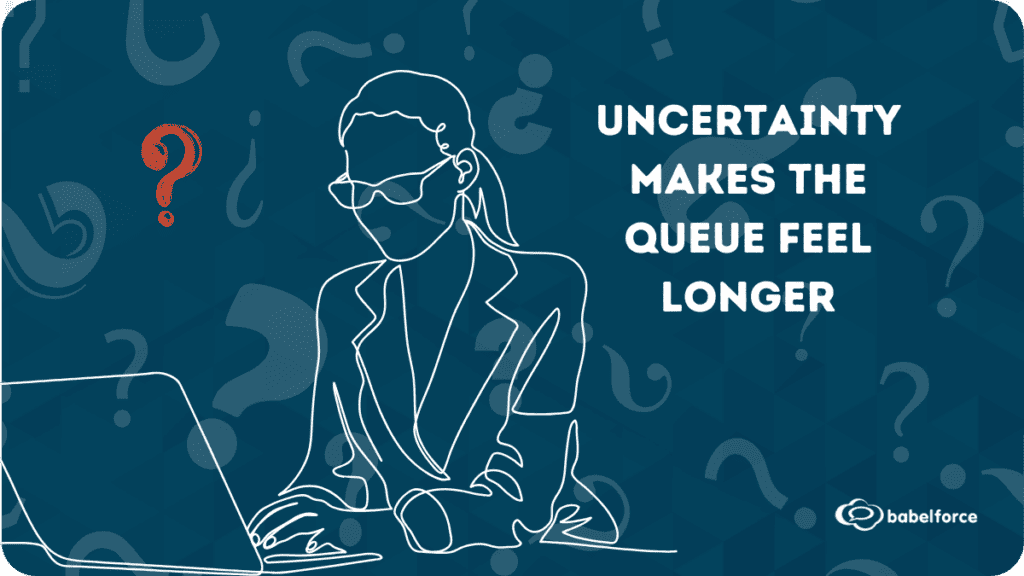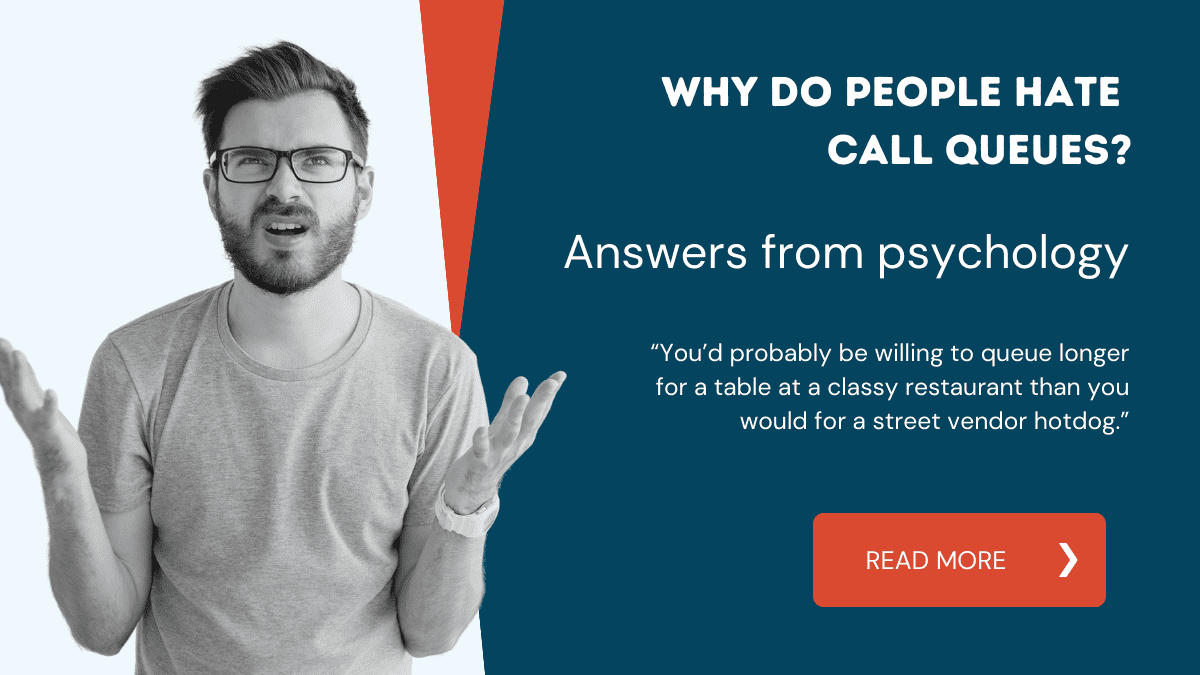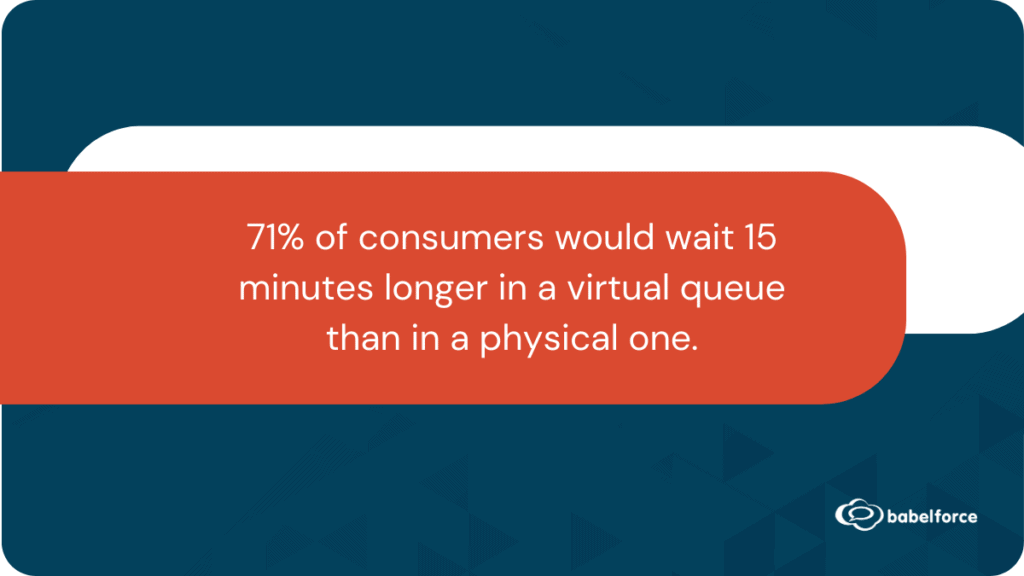Call queues are a universally dreaded aspect of calling customer service. No one likes to wait in line, whether it’s at the grocery store or on the phone with customer support.
But why do we hate waiting so much? What is it about being in a call queue that makes us feel irritated, frustrated, and downright angry? As it turns out, some scientists have gone out of their way to study the psychology behind our hatred of waiting – and we’ve got some answers for you.
In this article:
The psychology of waiting
As humans, we are hardwired to dislike waiting. 60% of us say that we wouldn’t be willing to wait longer than one minute in a call queue. Waiting in a call queue forces us to put our lives on hold and relinquish control over our time. Especially today, when we’re used to getting everything at the touch of a button, waiting for something can feel like an eternity. We become anxious and feel like we’re wasting our time.
So, what makes call queues so intolerable? Why do some people get more impatient than others? And why are we willing to wait for some things, but not others?
Back in 1985, David Maister, a Harvard Business School professor, spent some time studying the psychology of waiting. He identified several factors that influence our perception of wait times:
Uncertainty is the enemy
One major factor in our dislike for call queues is uncertainty. If we don’t know how long we will have to wait, what position we are in the queue, or if our call will even be answered at all, we become more anxious and frustrated.

The feeling of anxiety – a result of cortisol (a stress hormone) and other chemicals being released in our body – is a powerful emotion that can change our perception of time, making the wait feel even longer. You could say it becomes a bit of a vicious cycle. This is why announcements that inform us of our wait time or position in the queue can help alleviate some of our impatience.
Perceived unfairness in queues
Another factor is the perception of fairness. If we feel like others are getting preferential treatment or jumping ahead in line, we become even more impatient. Most of us have experienced this scenario at some point – you’re in a restaurant and see someone who came in after you get served before you do.
It goes without saying that in a call center queue, we can’t see who is ahead of us, but the feeling of unfairness can still persist if we feel like we should have been served by now or that our problem is more urgent than others’.

Mental state affects time perception
Our mental state also plays a role in how we perceive wait times. If we are already in a bad mood or stressed out, the wait can feel even longer. For example, in a scenario where you’re trying to sort out an issue like, “My bill is too high” or “My product isn’t working”, then you’re probably in a negative state of mind before even being put on hold. And for anyone in a stressed mental state, time perception stretches and warps even more, making the wait feel agonizingly long.
Boredom makes everything worse
When we have nothing to do while waiting, time seems to pass even slower. This is why call queues feel much longer than they actually are. We are left with unoccupied time, where our minds start to wander and we become fixated on how much longer we have to wait.
This is why some call centers have started using a call-back feature, where customers can request a callback instead of waiting in a queue. And since 71% of people say they would be willing to wait up to 15 minutes longer in a virtual queue than a real-time physical one, it’s a sound strategy.
Note, in this example, a traditional call queue is the same as a long line for the ticket booth because it has to be experienced in agonizing real time. Virtual in this case means that you can go about your life and be called back when you’ve reached the front.
But why are people more willing to wait longer if they’re not actually sitting on the phone? Because they can turn “unoccupied time” into “occupied time”. In other words, they can distract themselves from the waiting.
The value of the service plays a role
People are more willing to wait for something they feel is “worth it”. Would you be willing to wait 30 minutes for a gourmet meal at a classy restaurant with a great ambience? Probably. Would you be willing to wait 30 minutes for a street vendor hotdog? Not as much.
If you’re calling a company that already delivers excellent customer service, you’re likely to be more tolerant of a longer wait time. However, if you’ve had previous bad experiences with the company, a long wait time can feel like salt on an already open wound.
Unexplained wait times feel longer
Our expectations play a big role in how we perceive waiting. If we weren’t expecting to wait, and we don’t know why we’re waiting, the time seems to drag on even longer. Imagine you ordered something from a website and you expected it would arrive in a couple of days.
If two weeks pass and there’s no sign of the package, you’re likely to start getting annoyed and you’ll probably try to contact the company for an explanation. The same principle applies to waiting in a call queue. If you have no idea how long you’ll be waiting, it can feel like an eternity. This is why it’s important for companies to provide estimated wait times or reasons for the wait. It helps manage customer expectations and can alleviate frustration.
Can we make waiting better?
Since we know that certain factors make waiting worse, can call centers use this information to improve the waiting experience for customers? Absolutely! Most call centers already use some form of technology to make waiting less problematic for their customers. For example:
- Get creative with your hold music. Have you heard of the company to play a local radio station while customers wait for that little extra personal touch? Hold music doesn’t have to be boring!
- Call-back options. Instead of waiting on hold, some companies offer a call-back option where they’ll call you back at a certain time (or when an agent becomes available). This allows you to go about your day without being tethered to the phone.
- Virtual queuing. Similar to call-back options, virtual queuing allows you to hold your spot in line without actually being on the phone. This means you can do other things while waiting for your call to be answered.
- Queue position updates. Some companies have the tech in place to update you on your queue position, so you have a better idea of how much longer you’ll be waiting. This tackles the uncertainty factor and helps manage expectations.
- Efficient routing. Intelligent routing systems make it easier to direct callers to the right agent, reducing the overall wait time. It can also be used to route the most stressed-out customers with the most pressing issues to the front of the queue.
Yes, everyone hates waiting, but it doesn’t have to have to be the mental equivalent of watching paint dry. These are just a few ways call centers can make waiting more bearable for customers. So, next time you find yourself waiting on hold, remember that technology is working hard to make the experience a little bit more tolerable. Hang in there!






